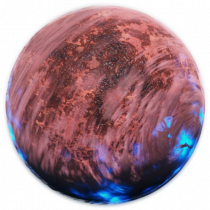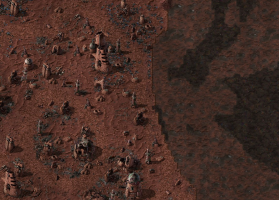Fulgora
| This article is a stub, and not comprehensive. |
|---|
| You can help this wiki by expanding it. |
![]() Space Age expansion exclusive feature.
Space Age expansion exclusive feature.
Fulgora is a new barren desert planet. Its surface is split between island-like plateaus, and deep oilsands. During the night, the planet is ravaged by lightning storms, damaging buildings.
Required Research
Exclusive Items
The following items are unlocked on Fulgora:
 Electromagnetic science pack
Electromagnetic science pack
 Electromagnetic plant
Electromagnetic plant
 Lightning collector
Lightning collector
 Lightning rod
Lightning rod
 Recycler
Recycler
 Tesla turret
Tesla turret
The following items are unlocked on Fulgora but can be crafted elsewhere:
Space routes
Fulgora is connected to 3 other planets: Nauvis, Gleba![]() , and Aquilo
, and Aquilo![]() .
.
| Planet | Distance (km) |
|---|---|
| Nauvis | 15,000 |
| Gleba |
15,000 |
| Aquilo |
30,000 |
Asteroid rate graphs:
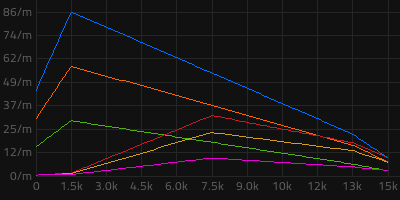 Space route from Nauvis to Fulgora |
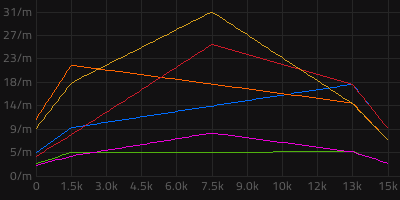 Space route from Gleba to Fulgora |
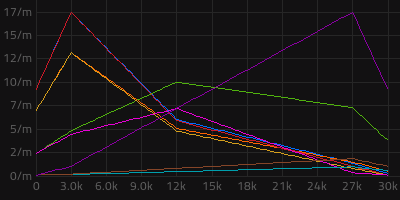 Space route from Fulgora to Aquilo |
Graph legend:
| Asteroid type | Chunk | Medium | Big |
|---|---|---|---|
| ● Blue | ● Red | ● Cyan | |
| ● Orange | ● Yellow | ● Brown | |
| ● Green | ● Magenta | ● Purple |
Orbit
Properties
| Property | Value |
|---|---|
| Solar Power | 120% |
| Asteroid Type | Spawn Ratio |
|---|---|
| Metallic asteroid chunk |
4 |
| Carbonic asteroid chunk |
3 |
| Oxide asteroid chunk |
1 |
| Promethium asteroid chunk |
0 |
| Asteroid Size | Spawn % |
|---|---|
| Chunk | .25 |
| Medium | .25 |
| Big | 0 |
| Huge | 0 |
Note:
- Chunks spawn at Nauvis at 1.25%
- Huge Asteroids only spawn past Aquilo

Surface
Properties
| Property | Value |
|---|---|
| Pollutant Type | None |
| Day Night Cycle | 3 Minutes |
| Magnetic Field | 99 |
| Solar Power | 20% |
| Pressure | 800 |
| Gravity | 8 |
Biomes
Fulgora is split between two distinct biomes.
- Plateaus are islands dotted around the landscape. They are the only biome where factories can be built. Some plateaus are home to alien ruins, which have rudimentary lightning rods, which can protect your buildings until unlocking your own lightning rods. Other plateaus hold scrap
 , Fulgora's sole resource.
, Fulgora's sole resource. - Oilsands are the lowlands between the plateaus. No buildings can be built in them except for rail supports
 . You can walk through them, but occasional oilpatches will slow you to a crawl. An offshore pump can be placed on the edge of oilsands to produce an unlimited amount of heavy oil.
. You can walk through them, but occasional oilpatches will slow you to a crawl. An offshore pump can be placed on the edge of oilsands to produce an unlimited amount of heavy oil.
Terrain
Fulgoran terrain is mainly composed of oillands, on which nothing except for rail supports can be built. Traversal by foot across the oillands is possible, but slow. The oillands are further divided into deep and shallow areas, with deep areas slowing down player movement even further and not even allowing for rail supports to be built without research.
However, the oillands are also scattered with islands of various sizes, on which normal construction is possible. At first, these are the only place on Fulgora where factories can be built, as foundation for building on top of the oillands requires research that can not be performed until much later.
The islands come in three size classes:
- Small islands with high amounts of resources, but with little room to build on
- Medium islands with lower amounts of resources, and with sufficient room for a small factory
- Large islands with no resources, but with enough room to build the main part of a medium-sized factory
It is possible for two or more islands to overlap, potentially creating an even larger island that does have local resources. However, most islands are detached, meaning that transport between islands will have to occur by train. In many cases, the distance between two islands is also too vast for roboports or big electric poles to reach, thus requiring local logistic and electric networks to be built, as neither roboports nor power poles can be built on the oillands without foundation.
Mechanics
Lightning
During nighttime, dense thunderstorms occur on Fulgora, with frequent lightning strikes occurring across the surface. Lightning will strike each chunk once, every 10 seconds or so ( lightnings_per_chunk_per_tick = 1 / (60 * 10), --cca once per chunk every 10 seconds (600 ticks) )
If a lightning strike is set to occur near a lightning rod, lightning collector, or fulgoran lightning attractor, then the lightning will always hit said entity, rendering the lightning harmless. However, if such an entity can not be found, the lightning will strike where it occurs, causing damage to nearby entities.
Lightning will target entities based on priority first and then random for any entity not on the priority list (Higher priority gets hit first)
| Entity | Priority Value |
|---|---|
| Lightning collector |
10,000 |
| Lightning rod |
1,000 |
| Fulgoran ruin vault | 95 |
| Fulgoran ruin colossal | 94 |
| Fulgoran ruin huge | 93 |
| Fulgoran ruin big | 92 |
| Fulgoran ruin medium | 91 |
The following items have a priority of 1:
- Pipe
- Pump
- Offshore pump
- Small electric pole
- Medium electric pole
- Big electric pole
- Substation
- Power switch
- Logistic robot
- Construction robot
- Anything with the "Metal" impact soundset
The following entities cannot be struck by the lightning:
- Rail support
- Rail
- Rail ramp
- Rail signal
- Rail chain signal
- Locomotive
- Artillery wagon
- Cargo wagon
- Fluid wagon
- Wall
- Tree
- Any item that counts as rock for "filtered destruction" (presumably this means Recycler)
When a lightning rod or a lightning collector is struck by lightning, it will generate a brief but powerful burst of electric energy, which can be utilized by connecting it to the electric network. With enough accumulators to last during daytime or between lightning strikes, this can serve as the factory's main power source.
With this, lightning on Fulgora become both a curse and a blessing: Players must keep their factory covered by lightning rods or collectors to avoid damage, and nighttime exploration becomes dangerous and risky. However, to an established base, lightning become a convenient source of electric energy, which is especially important given the weak solar output on Fulgora's surface and the difficulty of setting up a global electric network on Fulgora before foundation becomes available.
Natural resources
Aside from numerous items that can be collected by mining ancient ruins, only two "natural" resources occur on Fulgora, those being heavy oil and scrap.
Heavy oil can be obtained in infinite and non-diminishing amounts by placing an offshore pump on the shore of an island, allowing it to collect heavy oil directly from the oillands.
Scrap is found in deposits on small and medium sized islands, as if it were an ore. However, in stark contrast to most other natural resources, scrap is not directly processed into a single basic resource like iron or copper plates using traditional production methods. Rather, it is recycled to produce a variety of items:
- Ice

- Stone
- Holmium ore

- Concrete
- Solid fuel
- Steel plate
- Copper cable
- Iron gear wheel
- Battery
- Advanced circuit
- Processing unit
- Low density structure
Since this list includes intermediate products, such as processing units, but no iron or copper plates, players are often forced to further recycle many of these items in order to obtain their ingredients. Players are thus left with the decision of what items to recycle, all while having to avoid cluttering their belts with unused resources.
Access to basic resources
- Water can be obtained from Ice via Ice melting
- Stone comes from recycling Scrap
- Iron ore and iron plates can be obtained by recycling Scrap
- Copper ore is not available, but copper plates can be obtained by recycling Scrap
- Coal cannot be obtained and must be shipped in from other planets. However:
- Plastic bars can be obtained by by recycling Scrap
- Crude oil is not available, but Heavy oil is readily available using offshore pumps
Gallery
Trivia
- The planet's ruins suggest that an unknown civilization once existed there before the game's events.
- In mythology, Fulgora is the Roman personification of lightning, and a shieldmaiden to the god of thunder, Jupiter.
